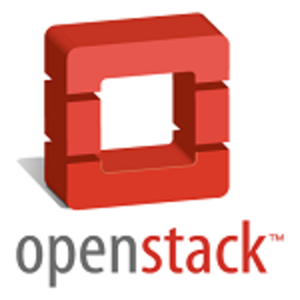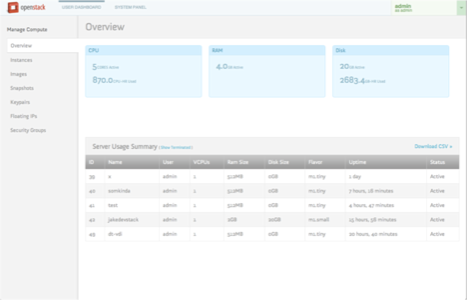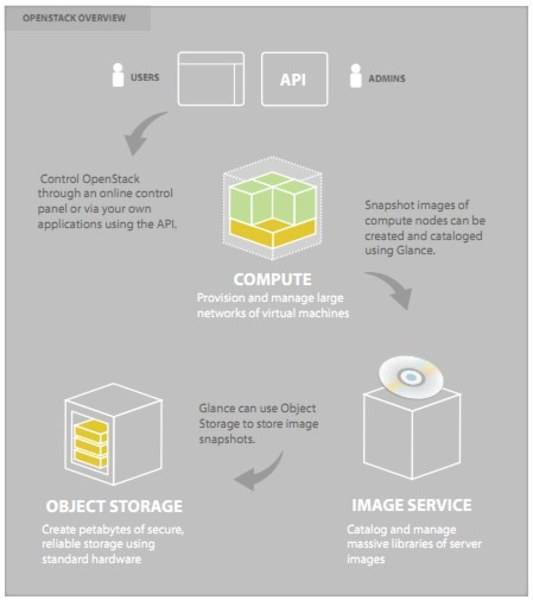The OpenStack Project is moving a bit closer to its proprietary competition with the Diablo release, out today. In addition to improving the three core projects, OpenStack is now adding a Web-based dashboard, unified authentication and an API for configuring virtual networks. With Diablo, OpenStack is poised to manage global clouds.

The OpenStack Project has made impressive gains since its inception just a little more than a year ago. OpenStack has gone from a joint project between RackSpace and NASA to a massive effort spanning 110 companies and organizations.
What’s New in Diablo
OpenStack Diablo improves the existing core projects: Nova (compute), Swift (object storage) and Glance (image storage) and adds two to the OpenStack Incubator. The new projects are Dashboard and Keystone.
Dashboard, as the name implies, is a new Web-based dashboard for managing and provisioning OpenStack-based clouds. Development of Dashboard is being led by Nebula, a company that’s basing its business on OpenStack. Nebula’s Devin Carlen, says that having a dashboard is key to adoption of OpenStack. “If you look at the adoption curves of Amazon Web Services, once they rolled out a Web-based control panel it took off. Having an official UI for OpenStack will drive OpenStack adoption.”
OpenStack Web-based Dashboard

The Keystone project will provide unified authentication across OpenStack projects and will integrate with other identity management tools in an organization. This means that companies won’t be stuck managing separate users for each OpenStack service and other internal services. Jonathan Bryce, chairman of the OpenStack project policy board, says that this will integrate with Microsoft’s Active Directory and LDAP systems, among others.
Keystone and Dashboard will become part of the “core” OpenStack project with the next release, Essex.
Quantum is a new incubator project that will debut in the Essex project cycle. Quantum is a networking API project led by Cisco, Citrix, Midokura, Nicira and Rackspace. It will allow dynamic network configuration and should extend beyond setting up virtual networking to managing physical network devices as well.
Going Global
In addition to better management features and user integration, the updates to the current core OpenStack projects are aimed at making OpenStack ready for global deployments.
- Nova is adding a distributed scheduler so that virtual machines can be deployed globally. It’s also getting a new identity stack (OpenStack Identity Management) and high availability networking mode.
- Object Storage (Swift) is getting multi-cluster container sync – which will allow organizations to choose how to replicate data across clusters.
- Glance, OpenStack’s image service, is getting new filtering and search capabilities in its API so that it’s easier to search through available images.

Nothing revolutionary, but a set of new features that bring OpenStack closer (if not on par) with offerings like Amazon Web Services.
The Linux of the Cloud
OpenStack has been criticized by some like Adrian Cockcroft (Netflix’s cloud architect) as “the consortium of people who can’t figure out how to compete with AWS on their own.” Well, he’s half-right.
OpenStack is a consortium of organizations that don’t want or need to compete with AWS on their own. Like Linux, OpenStack leverages the work of a much larger developer community to provide a cloud operating system that can be tailored to fit a variety of needs. It’s true that, alone, RackSpace would have had a hard time trying to keep up with AWS. Alone, Red Hat would have had a hard time making a dent in proprietary UNIX or Microsoft’s push into the server market.
With or without Netflix’s help, OpenStack is becoming a production-ready set of tools that can be used to build cloud services competitive with AWS and other proprietary cloud offerings. It’s not going to put Amazon out of business – but it doesn’t have to. It does provide a viable alternative for companies looking to build private cloud infrastructure and for vendors that want to offer cloud services.
OpenStack isn’t yet at par with AWS, and it may never be entirely feature-competitive with AWS. But, like Linux, it’s getting close enough that it will become a major player. Conversely, AWS will never be more than what Amazon makes of it. If what Amazon delivers is what you need, that’s great. But as we’ve seen with Linux, the ability to take a project and modify it to fit is often as important as the technology itself.










